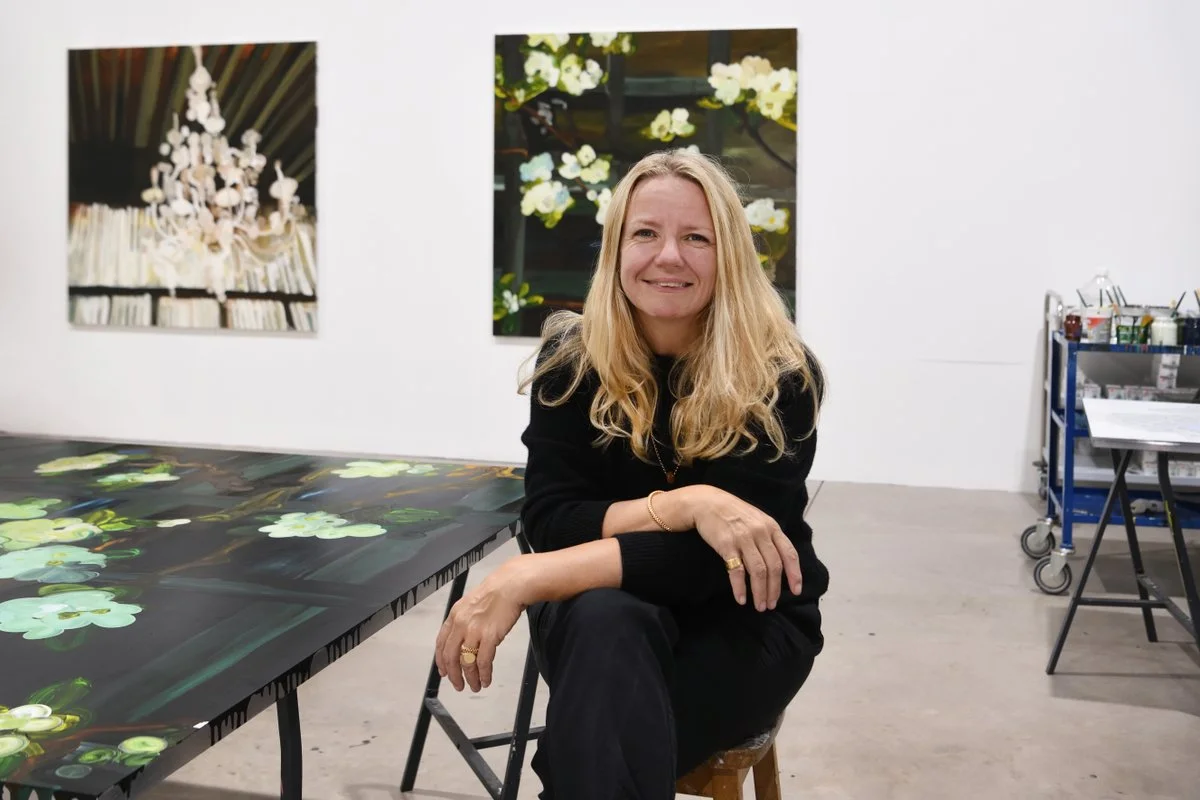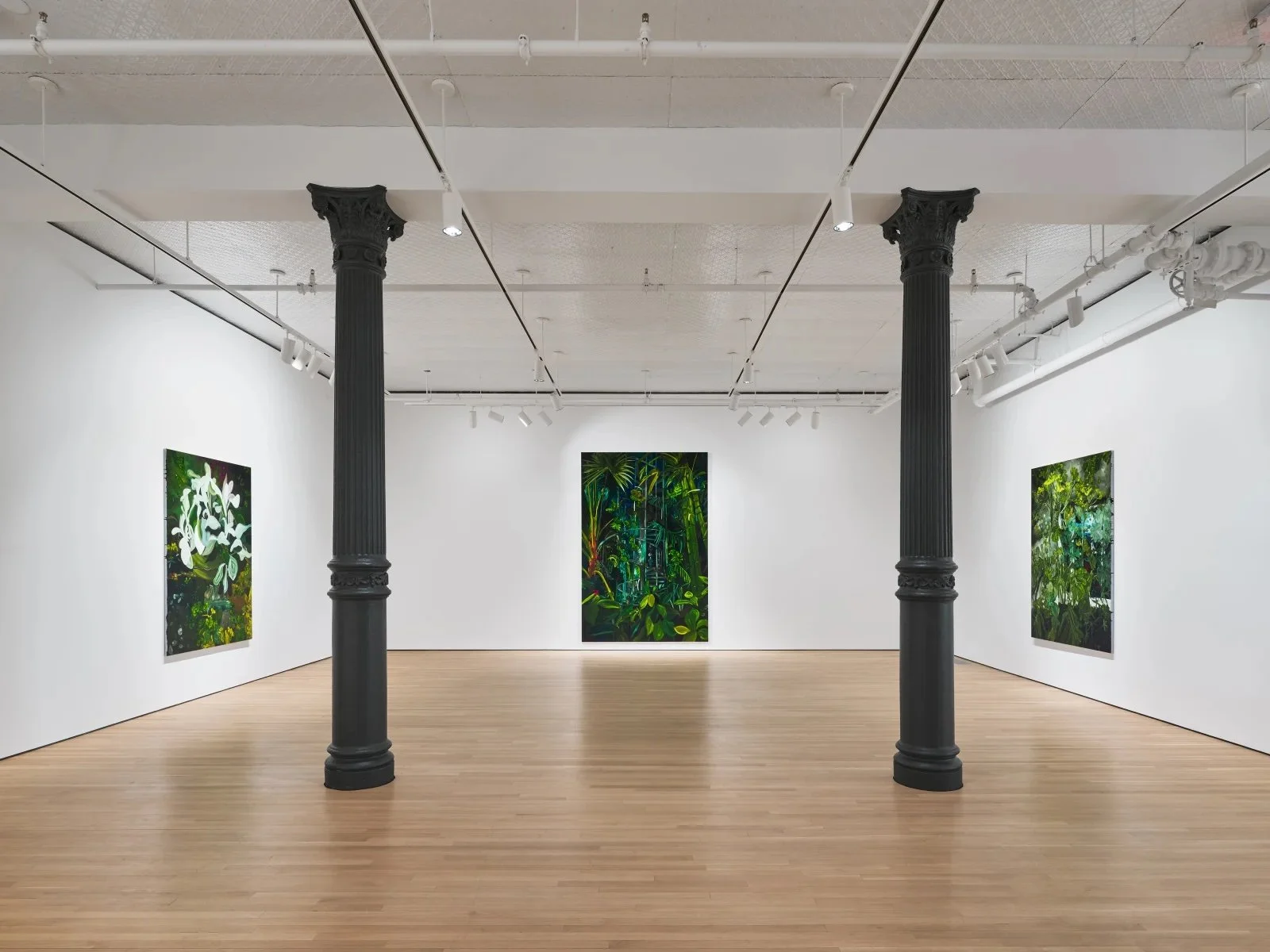Clare Woods: The Multiplicity of Still-Life
Translating work from one medium to another is a difficult feat that often begs the question of what's changed. The new form lives in a liminal state—born out of another idea or image and yet novel unto itself. British artist Clare Woods thrives at this intersection, whose classical training as sculptor comes through in her paintings as she blends sculptural techniques to produce oil paintings that richly explore the multiplicity of life.
Woods embraces this translation process at every stage: black and white photographs get transformed into loose drawings which are then transposed onto aluminum surfaces delineated by masking tape. These borders define the boundaries for Woods' vibrant brushwork. The actuality of making one of these paintings is quite laborious; they are done in one day, some taking 10+ hours, necessitated in part because of the wet-on-wet technique. The sculptural training markedly influences this process as Woods paints with the aluminum laid flat on the ground—painting from above using the full force of her shoulders to drive and carve the oil paint across the surface. Woods understands this pastiche of creation, stating: "I suppose what I'm actually doing is looking at something that exists, something that actually really exists in the real world and then photographing it and then trying to reinstate it in a way that I see it, which might be slightly different to how it actually is." This process results in a collection of still-life paintings that represent a disparate view that challenges contemporary culture.
The very term "still-life" suggests restraint, which seems at odds with the current always-on society. Today, people consume more photographs daily than most previous generations could imagine and remain constantly aware of how people choose to be seen or represented. Woods does not altogether condemn the current visual culture - she even actively engages on Instagram. However, in the deliberate brush strokes of Woods' work one can find a panacea to the endless scroll.
In her painting The Victory Garden, a large blue-green vase is overflowing with pink-hued flowers in various states of decay, wilting over the edges of the table. This foregrounded arrangement contrasts against a tonally darker background featuring thick, dark purple-hued vertical brushstrokes that hem in the light. The lack of certainty of what the flowers suggest adds to the richness of the painting—a temporary beauty marking a fated end. On this particular piece Woods herself notes that "there's always a sadness or a dark side. It's not just—there's a beautiful vase of flowers and I really want to paint them. It's like, oh, those dead flowers dropping with that purple velvet curtain behind looks really sinister or that reminds me of this grim feeling or that—there's always another side to this." This work along with several others can be seen in Woods’ exhibit “A Kinder Time” at the Stephen Friedman Gallery, marking her New York debut. Several of these paintings started during the pandemic when Woods was surrounded at home with these domestic objects.
Historically, still-life art has been devalued in part due to patriarchal and hierarchical scholarship that did not elevate ordinary domestic objects as important or worthy of scholarly attention. Woods' connection to the famous British tradition of still-life artistry becomes more apparent when looking at her 2025 painting The Day After. Woods was inspired by a photograph from Charleston in the UK, which was home to many members of the Bloomsbury group. This connection elucidates Vanessa Bell as a significant precursor to Woods and offers a critical lens to further contextualize Woods' work.
Though often recognized mainly for being Virginia Woolf's sister, Vanessa Bell was an innovative artist in her own right who typified the emerging modernist movement in her work. Her still-life portraits dismantled the impressionistic sensibility and instead depicted daily life teeming with bright colors. Like Woods, Bell frames her understanding of a rapidly shifting world by returning to the scene of the domestic. Both showcase a deep understanding and mastery of craft, and are not constrained by a single movement. Woods typifies this exploration in her work titled Victory Garden, a clear allusion to the gardens commemorating fallen British soldiers from the War. Bell and Woods' work, when considered in conversation, offers a deeper look into how artists grapple with the world during times of heightened divisions and uncertainty, often reflecting it back through common objects that serve as anchors of shared humanity.
“I think it’s always just trying to find a truth, to understand a truth or to try and really understand something and make a better painting, make a painting that gives me an understanding of what it is to be here... to understand life in some way.”
These touchpoints that anchor Woods' paintings also add to the timelessness of her still-life work. She herself notes, "Sometimes I don't really understand the paintings until maybe six months or a couple of years after and then… retrospectively looking back at work I made a couple of years ago, I can say, oh, yes, I really, really get that." Her painting Valley Forge (2024) stands apart for drawing inspiration from the past and present, while offering a nod towards an uncertain future. The painting depicts a futuristic blue glass dome enclosing flourishing gardens of greenery. While based on photographs from a trip to Los Angeles' Huntington Gardens, Woods said the painting also pulls inspiration from the 1972 sci-fi movie Silent Running. Glass is a constant motif across Woods' works; she remarked that when she was thinking about glass as it relates to gardens she's visited, she realized that "if glass wasn't there, they [the flowers] would be dead.… It's a filter and it's a boundary and that's what's been interesting about it in the work." As Woods explores the thin boundary between life and death, beauty and horror, she discovers and reflects the ephemeral nature of life.
Flowers are often the markers of seminal moments in life: adorning graves, filling wedding bouquets, celebrating baptismal ceremonies, or commemorating relationships through dried pressed flowers between the pages of a book. Woods' body of work showcases that a single image of a flower vase can contain a multitude of life’s moments. Her work serves as a ceremonial guide—a reflection on pure duration in the sense of how life is lived—suggesting that the rituals that define life are embodied in everyday objects and best understood with time.






